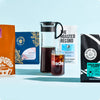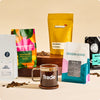Hello, coffee lover! We know brewing great coffee can seem really intimidating, and that the sheer number and complexity of brewing guides out there don’t help matters, so we’ve decided to help. Rather than think about coffee-brewing expertise as something you have to have right now, let’s look at it like a relay race: It’s much easier to run a marathon for the first time if you break it up into chunks.
You, my friend, are becoming a coffee expert in short order, and your dialing in has reached chef’s kiss proportions. Let’s put everything we’ve learned together in order to examine the anatomy of a coffee extraction together — trust us, it’s a lot more fun than dissecting frogs in science class.
If you’ve been following along with our tiny brewing lessons, you probably have your cup fairly well calibrated at this point. Feeling good? Check. Tasting great? Also check. Now we’re going to take the coffee you’re brewing and taste it a little more closely in order to start to understand what’s really happening throughout the course of a brew.
It’s important to remember that no matter what your extraction method is, the process itself is just that: a process, happening over the entire course of the brew. To help you visualize it, imagine yourself putting a bag of black tea into a clear mug full of hot water. At first you’ll see a little bit of the water around the bag turn brown, as the water dissolves the soluble materials, right? The longer the bag is in the water (and the more you dunk it up and down), the more color — and, of course, flavor — the water takes on.
Coffee is the same way, but unless we brew with a French press or use tea bags full of coffee grounds, we usually don’t see it as clearly because it happens inside the coffee filter, and the liquid comes out, well, coffee colored.
Now that you’ve started to understand the concepts behind proper extraction and proper dilution, we’re going to actually taste why getting it right is so important. This is one of our favorite exercises, and you don’t even have to brew coffee three times for this one. Just twice. (wink)
Using a drip brewer of some type is the easiest for this exercise, so we recommend that. (You can definitely use an electric dripper or an espresso machine for this one.) Have a set of small cups nearby from the start so you have something to separate the extraction into, and you’ll also want to make sure you have a timer handy, because we’re going to taste the brew in minute-long increments.
Step-by-step instructions
- Get ready to brew a batch of coffee using the coffee-to-water ratio, grind size, calibrated brew time, and 195 to 205°F water that you’ve gathered from our exercises so far. As soon as you begin brewing, make sure to hit your timer, and proceed with the brew as you normally do
- When the timer reads one minute, swap out your brewing carafe or mug so you can keep the coffee you’ve already brewed separate. This might take a bit of fast handiwork, but don’t stress if it’s not an absolutely seamless transition
- Continue brewing as normal, and repeat step two when you reach two minutes on your timer
- Repeat steps one to two at three minutes, and again at four minutes — yes, even if your usual brew ends before the four-minute mark
- You should now have four cups that each have a small amount of liquid in them. Go ahead and taste them and record your results!
As you’re tasting the coffees, remember that we’re looking for bitterness, sourness, and sweetness — which of the brews tastes the sweetest? Does one of the cups taste noticeably more sour or bitter than the others, and why do you think that would be? Think about which of these four cups might be the most under- or over-extracted. Do you notice that the fruity or sweet notes of the coffee turn up in one more than the others?
Once you’ve finished this lesson, you deserve a diploma — or at least a really great bag of coffee! Maybe it’s a good time to treat yourself to something special as a reward?
Good luck, have fun, and happy brewing!






